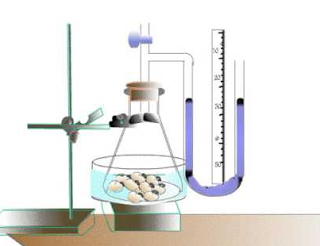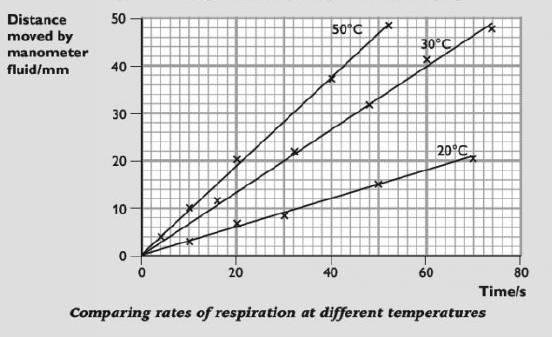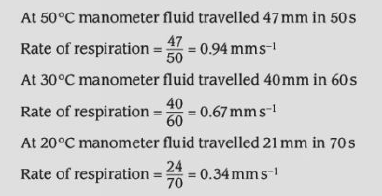Biology
 A respirometer is a device used to measure the rate of respiration of a living organism by measuring its rate of exchange of oxygen and/or carbon dioxide. They allow investigation into how factors such as age, chemicals or the effect of light affect the rate of respiration.
A respirometer is a device used to measure the rate of respiration of a living organism by measuring its rate of exchange of oxygen and/or carbon dioxide. They allow investigation into how factors such as age, chemicals or the effect of light affect the rate of respiration.
There are various different types of respirometer. One type is shown in the diagram.

Using a respirometer to measure the rate of uptake of oxygen
The organisms to be investigated are placed in one tube, and non-living material of the same mass in the other tube. Soda lime is placed in each tube, to absorb all carbon dioxide. Cotton wool prevents contact of the soda lime with the organisms.
Coloured fluid is poured into the reservoir of each manometer and allowed to flow into the capillary tube. It is essential that there are no air bubbles. You must end up with exactly the same quantity of fluid in the two manometers.
Two rubber bungs are now taken, fitted with tubes as shown in the diagram. Close the spring clips. Attach the manometers to the bent glasstubing, ensuring an airtight connection. Next, place the bungs into the tops of the tubes.
Open the spring clips. (This allows the pressure throughout the apparatus to equilibrate with atmospheric pressure.) Note the level of the manometer fluid in each tube. Close the clips. Each minute, record the level of the fluid in each tube.
As the organisms respire, they take oxygen from the air around them and give out carbon dioxide. The removal of oxygen from the air inside the tube reduces the volume and pressure, causing the manometer fluid to move towards the organisms. The carbon dioxide given out is absorbed by the
soda lime. The distance moved by the fluid is therefore affected only by the oxygen taken up and not by the carbon dioxide given out.
You would not expect the manometer fluid in the tube with no organisms to move, but it may do so because of temperature changes. This allows you to control for this variable, by subtracting the distance moved by the fluid in the control manometer from the distance moved in the experimental
manometer (connected to the Living organisms), to give you an adjusted distance moved.
Calculate the mean (adjusted) distance moved by the manometer fluid per minute. If you know the diameter of the capillary tube, you can convert the distance moved to a volume:
This gives you a value for the volume of oxygen absorbed by the organisms per minute.
Using a respirometer to investigate the effect of temperature on the rate of respiration
The respirometer can be placed in water baths at different temperatures. You can use the same respirometer for the whole experiment. Or you could have different ones for each temperature. (In each case, there are difficulties with controlling some variables - you might like to think about what these are.) At each temperature, you need a control respirometer with no organisms in it.
If you are simply comparing the rates of respiration at different temperatures, then you do not need to convert the distance moved by the manometer fluid to a volume. You could just plot distance moved on the y-axis of your graph and time on the x-axis.
The rate of respiration is represented by the gradient of the graph.


Using a respirometer to measure RQ
For this, we need to know both how much oxygen is taken in, and how much carbon dioxide is given out.
Set up two respirometers as shown above. However, the second respirometer should also contain the same mass of live maggots (or whatever organism you are investigating) but should not contain soda lime. You could put some inert material into the tube (for example, the beads) instead of soda lime. The mass and volume of the inert material should be the same as the mass and volume of the soda lime.
This second tube is therefore just like the first one except that it does not contain soda lime. The carbon dioxide given out by the respiring organisms is therefore not absorbed.
The difference between the distance moved by the manometer fluid in the experimental tube and the distance moved in the control tube is therefore due to the carbon dioxide given out.

For example, if the respiratory substrate is carbohydrate, then the amount of carbon dioxide given out will equal the amount of oxygen taken in. The fluid in the control tube will not move, so y=O.

- The Carbon Cycle
Carbon Cycles:Carbon can travel from the atmosphere into many place such as plants like grass. At this point in time, the carbon dioxide is either released back into the atmosphere or if the plant dies, it is put into the soil. Even after this, the carbon...
- #105 Limiting Factors In Photosynthesis
A limiting factor is a factor that controls a process. Light intensity, temperature and, CO2 concentration and availability of H2O are all factors which can control the rate of photosynthesis. Usually, only one of these factors will be the limiting...
- #97 Summary Of Energy And Respiration
1 Organisms must do work to stay alive. The energy input necessary for this work is either light, for photosynthesis, or the chemical potential energy of organic molecules. Work includes anabolic reactions, active transport and movement. Some organisms,...
- #93 Respiratory Substrates, Respiratory Quotions
A respiratory substrate is a molecule from which energy can be liberated to produce ATP in a living cell. Glucose is not the only respiratory substrate. All carbohydrates, lipids and proteins can also be used as respiratory substrates. Many cells in...
- #69 How To Get High Marks In Paper 3 - Variables
Many of the experiments that you will do during your AS course, and usually Question 1 in the examination paper, will investigate the effect of one factor on another. These factors are called variables. Types of variables The factor that you change...
Biology
#96 Using respirometers

There are various different types of respirometer. One type is shown in the diagram.

Using a respirometer to measure the rate of uptake of oxygen
The organisms to be investigated are placed in one tube, and non-living material of the same mass in the other tube. Soda lime is placed in each tube, to absorb all carbon dioxide. Cotton wool prevents contact of the soda lime with the organisms.
Coloured fluid is poured into the reservoir of each manometer and allowed to flow into the capillary tube. It is essential that there are no air bubbles. You must end up with exactly the same quantity of fluid in the two manometers.
Two rubber bungs are now taken, fitted with tubes as shown in the diagram. Close the spring clips. Attach the manometers to the bent glasstubing, ensuring an airtight connection. Next, place the bungs into the tops of the tubes.
Open the spring clips. (This allows the pressure throughout the apparatus to equilibrate with atmospheric pressure.) Note the level of the manometer fluid in each tube. Close the clips. Each minute, record the level of the fluid in each tube.
As the organisms respire, they take oxygen from the air around them and give out carbon dioxide. The removal of oxygen from the air inside the tube reduces the volume and pressure, causing the manometer fluid to move towards the organisms. The carbon dioxide given out is absorbed by the
soda lime. The distance moved by the fluid is therefore affected only by the oxygen taken up and not by the carbon dioxide given out.
You would not expect the manometer fluid in the tube with no organisms to move, but it may do so because of temperature changes. This allows you to control for this variable, by subtracting the distance moved by the fluid in the control manometer from the distance moved in the experimental
manometer (connected to the Living organisms), to give you an adjusted distance moved.
Calculate the mean (adjusted) distance moved by the manometer fluid per minute. If you know the diameter of the capillary tube, you can convert the distance moved to a volume:
volume of liquid in a tube - length x ?r2
Using a respirometer to investigate the effect of temperature on the rate of respiration
The respirometer can be placed in water baths at different temperatures. You can use the same respirometer for the whole experiment. Or you could have different ones for each temperature. (In each case, there are difficulties with controlling some variables - you might like to think about what these are.) At each temperature, you need a control respirometer with no organisms in it.
If you are simply comparing the rates of respiration at different temperatures, then you do not need to convert the distance moved by the manometer fluid to a volume. You could just plot distance moved on the y-axis of your graph and time on the x-axis.
The rate of respiration is represented by the gradient of the graph.


Using a respirometer to measure RQ
For this, we need to know both how much oxygen is taken in, and how much carbon dioxide is given out.
Set up two respirometers as shown above. However, the second respirometer should also contain the same mass of live maggots (or whatever organism you are investigating) but should not contain soda lime. You could put some inert material into the tube (for example, the beads) instead of soda lime. The mass and volume of the inert material should be the same as the mass and volume of the soda lime.
This second tube is therefore just like the first one except that it does not contain soda lime. The carbon dioxide given out by the respiring organisms is therefore not absorbed.
The difference between the distance moved by the manometer fluid in the experimental tube and the distance moved in the control tube is therefore due to the carbon dioxide given out.


Syllabus: 12.2 Respiration m) carry out investigations, using simple respirometers, to measure the effect of temperature on the respiration rate of germinating seeds or small invertebrates |
- The Carbon Cycle
Carbon Cycles:Carbon can travel from the atmosphere into many place such as plants like grass. At this point in time, the carbon dioxide is either released back into the atmosphere or if the plant dies, it is put into the soil. Even after this, the carbon...
- #105 Limiting Factors In Photosynthesis
A limiting factor is a factor that controls a process. Light intensity, temperature and, CO2 concentration and availability of H2O are all factors which can control the rate of photosynthesis. Usually, only one of these factors will be the limiting...
- #97 Summary Of Energy And Respiration
1 Organisms must do work to stay alive. The energy input necessary for this work is either light, for photosynthesis, or the chemical potential energy of organic molecules. Work includes anabolic reactions, active transport and movement. Some organisms,...
- #93 Respiratory Substrates, Respiratory Quotions
A respiratory substrate is a molecule from which energy can be liberated to produce ATP in a living cell. Glucose is not the only respiratory substrate. All carbohydrates, lipids and proteins can also be used as respiratory substrates. Many cells in...
- #69 How To Get High Marks In Paper 3 - Variables
Many of the experiments that you will do during your AS course, and usually Question 1 in the examination paper, will investigate the effect of one factor on another. These factors are called variables. Types of variables The factor that you change...
